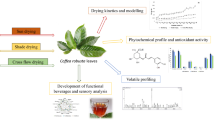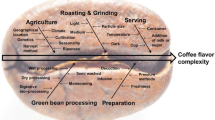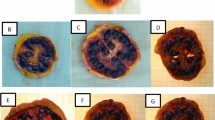Abstract
The spent coffee ground is a by-product of the coffee industry with high potential because of its beneficial properties for health, however, due to high water content, it is necessary to stabilize it without affecting bioactive capacities. The main objective of this work was to evaluate the effect of different convective drying conditions, on some technological and functional properties of the spent coffee ground and to determine the thermal degradation kinetics of chlorogenic acids. The methodology included the optimization of the drying process conditions of spent coffee ground: temperature (40–60 °C), air flow (1.0–2.0 m/s) and cake thickness (0.01–0.02 m). Effective diffusion coefficient, moisture, water activity, water and oil holding capacity, antioxidant capacity, caffeine, and seven chlorogenic acids were determined. The results showed that the best drying conditions were 60 °C, 2.0 m/s, 1.28 cm which allows retaining 84.24% of total polyphenols and 66.00% of the antioxidant capacity. Chlorogenic acids showed thermal degradation kinetics of first order under the optimal process conditions. In general, it is concluded that the convective drying process is a valid technique for processing of coffee grounds, as it allows the preservation of antioxidant compounds with a potentially beneficial effect on health, providing a stabilized low moisture content that can be used in food applications.
Graphic Abstract



Similar content being viewed by others
References
Limousy, L., Jeguirim, M., Dutournié, P., Kraiem, N., Lajili, M., Said, R.: Gaseous products and particulate matter emissions of biomass residential boiler fired with spent coffee grounds pellets. Fuel 107, 323–329 (2013)
Mussatto, S.I., Machado, E.M.S., Martins, S., Teixeira, J.A.: Production, composition, and application of coffee and its industrial residues. Food Bioprocess Technol. 4(5), 661–672 (2011)
Martinez-Saez, N., et al.: Use of spent coffee grounds as food ingredient in bakery products. Food Chem. 216, 114–122 (2017)
Esquivel, P., Jiménez, V.M.: Functional properties of coffee and coffee by-products. Food Res. Int. 46(2), 488–495 (2012)
Murthy, P.S., Madhava Naidu, M.: Sustainable management of coffee industry by-products and value addition—a review. Resour. Conserv. Recycl. 66, 45–58 (2012)
López-Barrera, D.M., Vázquez-Sánchez, K., Loarca-Piña, M.G.F., Campos-Vega, R.: Spent coffee grounds, an innovative source of colonic fermentable compounds, inhibit inflammatory mediators in vitro. Food Chem. 212, 282–290 (2016)
Gómez-De La Cruz, F.J., Cruz-Peragón, F., Casanova-Peláez, P.J., Palomar-Carnicero, J.M.: A vital stage in the large-scale production of biofuels from spent coffee grounds: the drying kinetics. Fuel Process. Technol. 130, 188–196 (2015)
Kovalcik, A., Obruca, S., Marova, I.: Valorization of spent coffee grounds: a review. Food Bioprod. Process. 110, 104–119 (2018)
Murthy, P.S., Naidu, M.M.: Recovery of phenolic antioxidants and functional compounds from coffee industry by-products. Food Bioprocess Technol. 5(3), 897–903 (2012)
Givens, D.I., Barber, W.P.: In vivo evaluation of spent coffee grounds as a ruminant feed. Agric. Wastes 18(1), 69–72 (1986)
Zuorro, A., Lavecchia, R.: Spent coffee grounds as a valuable source of phenolic compounds and bioenergy. J. Clean. Prod. 34, 49–56 (2012)
Peshev, D., Mitev, D., Peeva, L., Peev, G.: Valorization of spent coffee grounds—a new approach. Sep. Purif. Technol. 192, 271–277 (2018)
Campos-Vega, R., Loarca-Piña, G., Vergara-Castañeda, H.A., Dave Oomah, B.: Spent coffee grounds: a review on current research and future prospects. Trends Food Sci. Technol. 45(1), 24–36 (2015)
Sarkis, J.R., Mercali, G.D., Tessaro, I.C., Marczak, L.D.F.: Evaluation of key parameters during construction and operation of an ohmic heating apparatus. Innov. Food Sci. Emerg. Technol. 18, 145–154 (2013)
Franca, A.S., Oliveira, L.S., Ferreira, M.E.: Kinetics and equilibrium studies of methylene blue adsorption by spent coffee grounds. Desalination 249(1), 267–272 (2009)
Mussatto, S.I., Carneiro, L.M., Silva, J.P.A., Roberto, I.C., Teixeira, J.A.: A study on chemical constituents and sugars extraction from spent coffee grounds. Carbohydr. Polym. 83(2), 368–374 (2011)
Xu, H., Wang, W., Liu, X., Yuan, F., Gao, Y.: Antioxidative phenolics obtained from spent coffee grounds (Coffea arabica L.) by subcritical water extraction. Ind. Crops Prod. 76, 946–954 (2015)
Ramalakshmi, K., Rao, L.J.M., Takano-Ishikawa, Y., Goto, M.: Bioactivities of low-grade green coffee and spent coffee in different in vitro model systems. Food Chem. 115(1), 79–85 (2009)
Monente, C., Ludwig, I.A., Irigoyen, A., De Peña, M.P., Cid, C.: Assessment of total (Free and Bound) phenolic compounds in spent coffee extracts. J. Agric. Food Chem. 63(17), 4327–4334 (2015)
M. Misra, S. K. Mohapatra, and K. & N. V., Methods, systems, and apparatus for obtaining biofuel from coffee and fuels produced therefrom. Patent 8591605 B2, 2013.
Baechler, R.: Process for extracting terpens from spent coffee grounds. Patent 0819385, B1 (2002)
Kumar, N., Sarkar, B.C., Sharma, H.K.: Mathematical modelling of thin layer hot air drying of carrot pomace. J. Food Sci. Technol. 49(1), 33–41 (2012)
Sabarez, H.: Drying of Food Materials. Elsevier, Amsterdam (2016)
Onwude, D.I., Hashim, N., Janius, R.B., Nawi, N.M., Abdan, K.: Modeling the thin-layer drying of fruits and vegetables: a review. Compr. Rev. Food Sci. Food Saf. 15(3), 599–618 (2016)
Saavedra, J., et al.: Industrial avocado waste: Functional compounds preservation by convective drying process. J. Food Eng. 198, 81–90 (2017)
Kuljarachanan, T., Devahastin, S., Chiewchan, N.: Evolution of antioxidant compounds in lime residues during drying. Food Chem. 113(4), 944–949 (2009)
Dorta, E., Lobo, M.G., González, M.: Using drying treatments to stabilise mango peel and seed: effect on antioxidant activity. LWT Food Sci. Technol. 45(2), 261–268 (2012)
Duarte, Y. et al.: Effects of blanching and hot air drying conditions on the physicochemical and technological properties of yellow passion fruit (Passiflora edulis Var. Flavicarpa) by-products. J. Food Process. Eng. 40(3), 0–9, 2017.
AOAC: Official Methods of Analysis of AOAC International, 20th ed. Rockville: Association of Official Analytical Chemists, 2016.
Teba, C.S., da Silva, E.M.M., Chávez, D.W.H., de Carvalho, C.W.P., Ascheri, J.L.R.: Effects of whey protein concentrate, feed moisture and temperature on the physicochemical characteristics of a rice-based extruded flour. Food Chem. 228, 287–296 (2017)
Heldman, D.R., Lund, D.B., Sabliov, C.: Handbook of Food Engineering. Second Edition, Boca Raton (2006)
Crank, J.: The Mathematics of Diffusion, 2d ed. Oxford University Press, Oxford (1975)
Metzler, R., Klafter, J.: The random walk’s guide to anomalous diffusion: a fractional dynamics approach. Phys. Rep. 339, 1–77 (2000)
Contreras-Calderón, J., Guerra-Hernández, E., García-Villanova, B.: Utility of some indicators related to the Maillard browning reaction during processing of infant formulas. Food Chem. 114(4), 1265–1270 (2009)
Contreras-Calderón, J., et al.: Evaluation of antioxidant capacity in coffees marketed in Colombia: relationship with the extent of non-enzymatic browning. Food Chem. 209, 162–170 (2016)
Re, I.R., Pellegrini, N., Proteggente, A., Pannala, A., Yang, M., Rice-Evans, C.: Antioxidant activity applying an improved abts radical. Free Radic. Biol. Med. 26(98), 1231–1237 (1999)
Ludwig, I.A., Sanchez, L., Caemmerer, B., Kroh, L.W., De Peña, M.P., Cid, C.: Extraction of coffee antioxidants: impact of brewing time and method. Food Res. Int. 48(1), 57–64 (2012)
Gloess, A.N., et al.: Comparison of nine common coffee extraction methods: instrumental and sensory analysis. Eur. Food Res. Technol. 236(4), 607–627 (2013)
D. I. für Normung, DIN 10767:Analysis of coffee and coffee products; determination of chlorogenic acids content; HPLC method. 1992.
Vignoli, J.A., Bassoli, D.G., Benassi, M.T.: Antioxidant activity, polyphenols, caffeine and melanoidins in soluble coffee: the influence of processing conditions and raw material. Food Chem. 124(3), 863–868 (2011)
Osorio, K., Monjes, J., Pinto, M., Ramírez, C., Simpson, R., Vega, O.: Effects of spray drying conditions and the addition of surfactants on the foaming properties of a whey protein concentrate. LWT Food Sci. Technol. 58(1), 109–115 (2014)
Cruz, R., et al.: Espresso coffee residues: a valuable source of unextracted compounds. J. Agric. Food Chem. 60(32), 7777–7784 (2012)
Bravo, J., et al.: Evaluation of spent coffee obtained from the most common coffeemakers as a source of hydrophilic bioactive compounds. J. Agric. Food Chem. 60(51), 12565–12573 (2012)
Ramírez, C., Astorga, V., Nuñez, H., Jaques, A., Simpson, R.: Anomalous diffusion based on fractional calculus approach applied to drying analysis of apple slices: the effects of relative humidity and temperature. Food Process Eng. e12549, 1–10 (2017)
Zogzas, N., Maroulis, Z.B.: Moisture diffusivity data compilation in foodstuff. Dry. Technol. 2013, 37–41 (2007)
Guiné, R.P.F., Pinho, S., Barroca, M.J.: Study of the convective drying of pumpkin (Cucurbita maxima). Food Bioprod. Process. 89(4), 422–428 (2011)
Gan, P.L., Poh, P.E.: Investigation on the effect of shapes on the drying kinetics and sensory evaluation study of dried jackfruit. Int. J. Sci. Eng. 7, 193–198 (2014)
Akoy, E.O.M.: Experimental characterization and modeling of thin-layer drying of mango slices. Int. Food Res. J. 21(5), 1911–1917 (2014)
Shen, L., Chen, Z.: Critical review of the impact of tortuosity on diffusion. Chem. Eng. Sci. 62(14), 3748–3755 (2007)
Tjaden, B., Brett, D.J.L., Shearing, P.R.: Tortuosity in electrochemical devices: a review of calculation approaches. Int. Mater. Rev. 63(2), 47–67 (2018)
J. Salvador, Aplicación de microperforaciones utilizando laser-CO2 en el proceso de liofilización de alimentos: efecto en el tiempo de secado primario. Universidad Tecnica Federico Santa María, 2018.
Rojas, M.L., Augusto, P.E.D.: Microstructure elements affect the mass transfer in foods: the case of convective drying and rehydration of pumpkin. Lwt 93, 102–108 (2018)
de Moraes Crizel, T., Jablonski, A., de OliveiraRios, A., Rech, R., Flôres, S. H.: Dietary fiber from orange byproducts as a potential fat replacer. LWT Food Sci. Technol. 53(1), 9–14 (2013)
Panusa, A., Zuorro, A., Lavecchia, R., Marrosu, G., Petrucci, R.: Recovery of natural antioxidants from spent coffee grounds. J. Agric. Food Chem. 61, 4162–4168 (2013)
Méndez-Lagunas, L., Rodríguez-Ramírez, J., Cruz-Gracida, M., Sandoval-Torres, S., Barriada-Bernal, G.: Convective drying kinetics of strawberry (Fragaria ananassa): effects on antioxidant activity, anthocyanins and total phenolic content. Food Chem. 230, 174–181 (2017)
Horuz, E., Bozkurt, H., Karataş, H., Maskan, M.: Effects of hybrid (microwave-convectional) and convectional drying on drying kinetics, total phenolics, antioxidant capacity, vitamin C, color and rehydration capacity of sour cherries. Food Chem. 230, 295–305 (2017)
Wojdyło, A., Figiel, A., Lech, K., Nowicka, P., Oszmiański, J.: Effect of convective and vacuum-microwave drying on the bioactive compounds, color, and antioxidant capacity of sour cherries. Food Bioprocess Technol. 7(3), 829–841 (2014)
Naczk, N., Shahidi, F.: Phenolics in cereals, fruits and vegetables: Occurrence, extraction and analysis. J. Pharm. Biomed. Anal. 41(5), 1523–1542 (2006)
Puerta, G.: La humedad controlada del grano preserva la calidad del café. Cenicafé 352, 1–8 (2006)
D. L. Aurelio, R. G. Edgardo, S. Navarro-Galindo, Thermal kinetic degradation of anthocyanins in a roselle (Hibiscus sabdariffa L. cv. ’Criollo’) infusion. Int. J. Food Sci. Technol., 43(2), 322–325, 2008.
Farah, A.: Coffee constituents. In: Chu, Y.-F. (ed.) Coffee: Emerging Health Effects and Disease Prevention, 1st edn, pp. 21–58. Blackwell, Ames (2012)
Acknowledgements
The authors give special thanks to COLCIENCIAS for supporting, by the agreement 727-2015 scholarship. In addition, a special thanks to Universidad de Antioquia for the donation of the raw material. The authors are grateful for the financial support provided by CONICYT through FONDECYT project 1160811 (Cristian Ramírez) and 1181270 (Ricardo Simpson).
Funding
This work was supported by the Administrative Department of Science, Technology, and Innovation—Colciencias, Colombia [Convocatoria 727 de 2015].
Author information
Authors and Affiliations
Corresponding author
Ethics declarations
Conflict of interest
The authors declare that have no conflict of interest.
Additional information
Publisher's Note
Springer Nature remains neutral with regard to jurisdictional claims in published maps and institutional affiliations.
Rights and permissions
About this article
Cite this article
Osorio-Arias, J., Delgado-Arias, S., Cano, L. et al. Sustainable Management and Valorization of Spent Coffee Grounds Through the Optimization of Thin Layer Hot Air-Drying Process. Waste Biomass Valor 11, 5015–5026 (2020). https://doi.org/10.1007/s12649-019-00793-9
Received:
Accepted:
Published:
Issue Date:
DOI: https://doi.org/10.1007/s12649-019-00793-9




